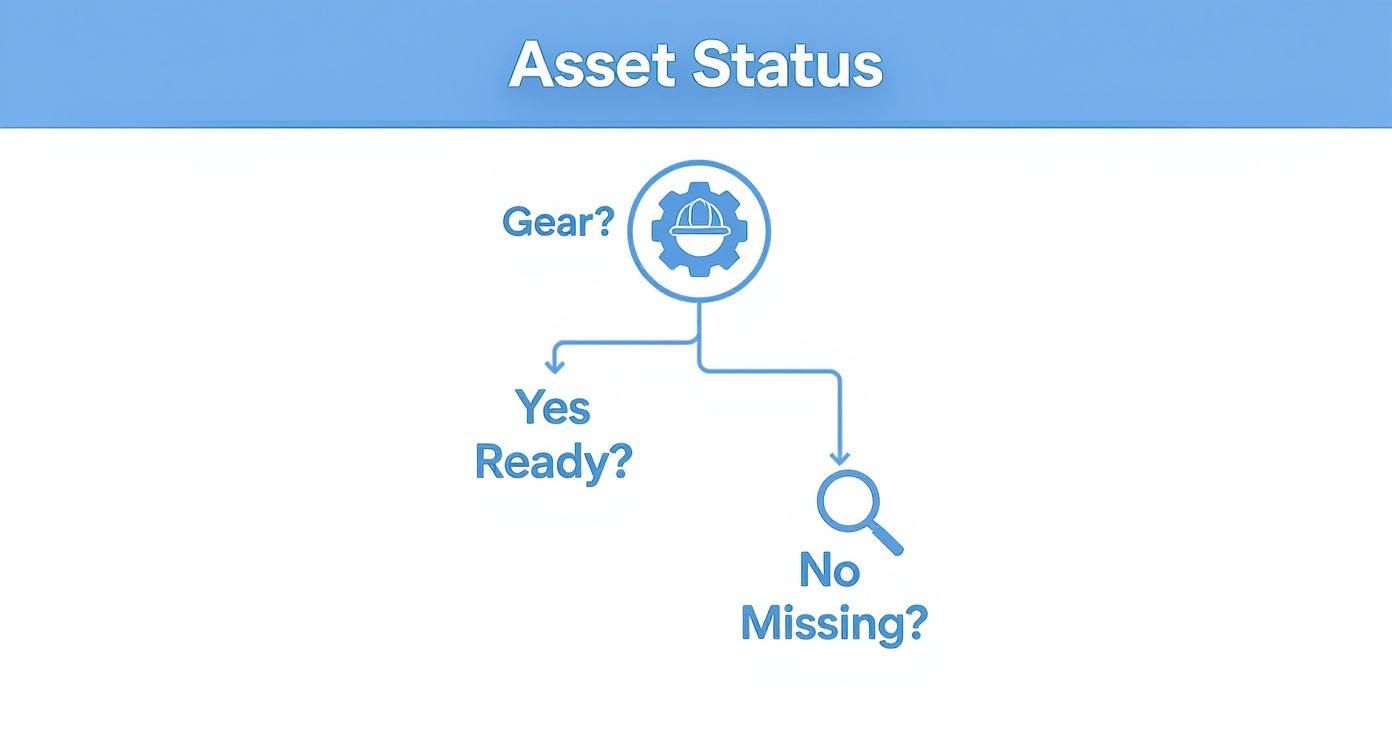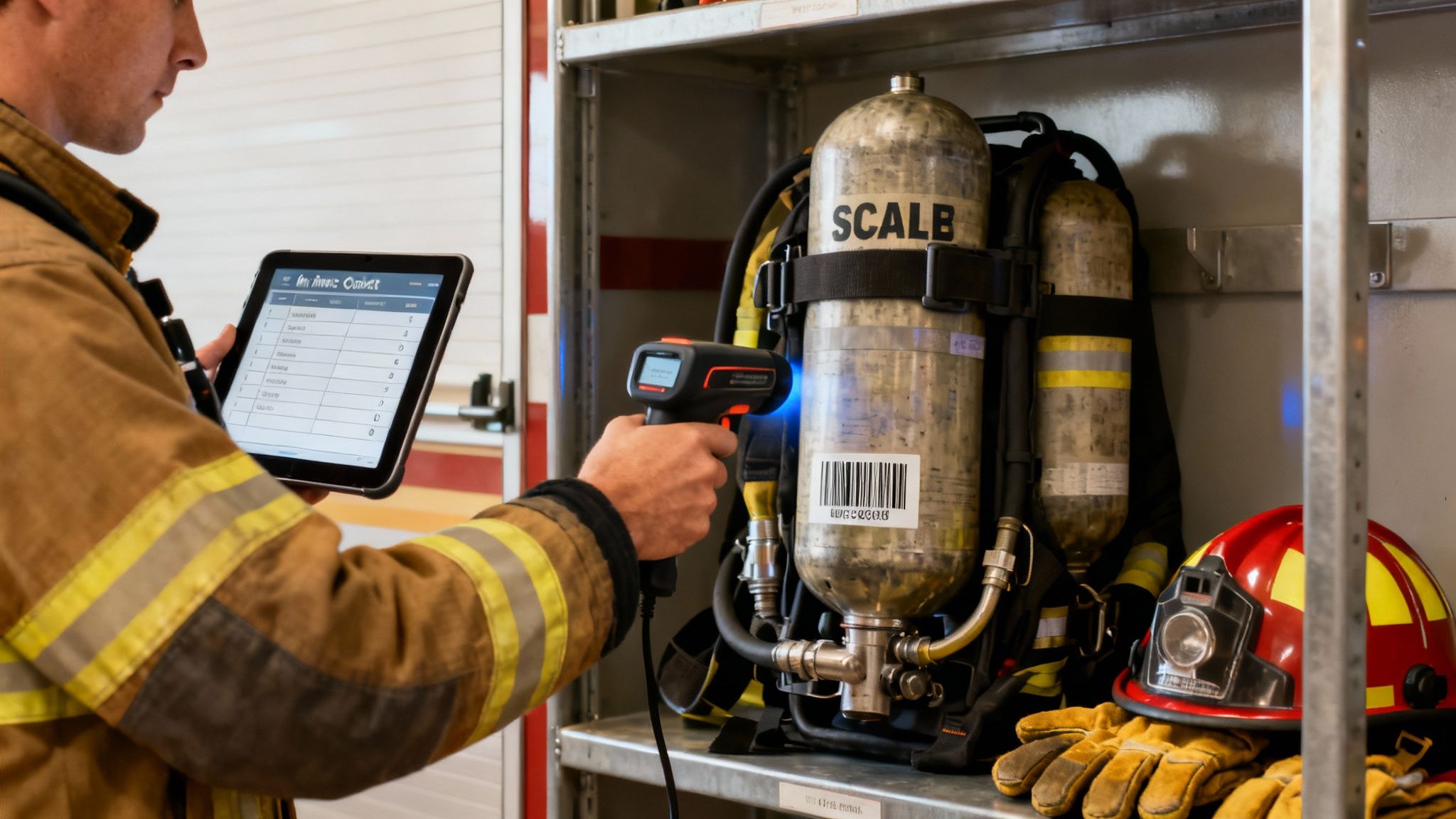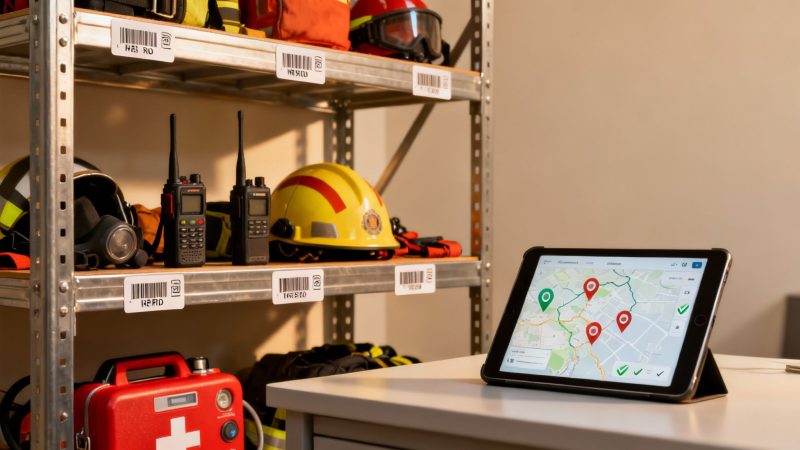First Responder Assets and Inventory Guide
For a first responder, assets and inventory aren't just line items on a spreadsheet. They're the lifeblood of every single call we run. Getting a handle on your gear isn't just some administrative chore—it's a core part of public safety that directly impacts response times, firefighter and medic safety, and the readiness of your entire operation.
When seconds count, a misplaced defibrillator or an uninspected SCBA can change an outcome for the worse. It’s that simple.
Why Asset Management Is Critical for First Responders
In our world, the line between an organized scene and a chaotic one often comes down to how well you manage your equipment.
Picture this: a multi-vehicle pile-up on the highway at 2 AM. The crew needs the hydraulic rescue tools—now. But the specific cutter head they grab from the truck hasn't been serviced in months, and it fails under the strain of a crushed A-pillar. That single point of failure, a direct result of poor asset tracking, can delay patient extrication and put the entire rescue in jeopardy.
This isn’t just about the big-ticket items, either. It’s the daily stuff, too. For example, running out of a specific pediatric IO needle on a critical call because the ambulance wasn't properly restocked is a preventable failure. Good management ensures every piece of gear, from turnout coats to trauma shears, is accounted for, inspected, and ready to go at a moment's notice.
Turning Data into Dollars and Safety
When you get a robust system in place for managing your assets and inventory, you gain a clear, real-time picture of your department's resources. That visibility pays off in some very real ways:
- Cost Savings: It stops you from buying duplicate equipment you didn't know you had and cuts down on losses from misplaced gear. Actionable Insight: A fire department recently saved over $5,000 in a single year just by reducing the loss of portable radios and thermal cameras after implementing a check-out system. Tracking maintenance history also squeezes every last drop of life out of expensive assets, saving huge replacement costs down the road.
- Enhanced Safety: It guarantees that all your critical equipment, like breathing apparatus and ladders, meets compliance standards and is regularly maintained. This is how you protect your team from catastrophic gear failure.
- Improved Readiness: It means critical supplies and tools are actually available and in working order. No more "search and rescue" missions for equipment inside your own firehouse when the tones drop.
By meticulously tracking every asset, a department can shift from a reactive, "fix it when it breaks" model to a proactive maintenance culture. This foresight not only saves money but, more importantly, ensures the tools that save lives will actually work when you need them most.
While managing first responder gear has its own unique challenges, looking at general IT asset management best practices can offer some surprisingly useful insights for optimizing costs and keeping everything compliant. The core principle is exactly the same: know what you have, where it is, and what condition it's in. That foundational knowledge is just as vital as any tactical training you'll ever do.
Choosing The Right Tagging Method For Your Gear
Deciding how to tag your equipment is the single biggest step toward real control over your station’s inventory. It’s not about picking the most expensive gadget—it’s finding something tough enough to handle mud, heat, and hurried shifts. Plus, your choice will shape your budget and determine how quickly your team adapts to the new routine.
In the sections that follow, we’ll explore three proven approaches—barcodes, RFID, and GPS—to help you match each piece of gear with the right tracking tool.
Barcodes: The Workhorse Of Inventory Management
Barcodes are often underestimated. Yet they remain the go-to for straightforward, cost-conscious tagging. You can roll out hundreds of barcode labels in minutes, stick them on almost any surface, and scan with any handheld device.
• Best For: High-volume, lower-cost items that stay mostly in the station—think fire hoses, turnout gear lockers, and supply bins.
• Cost Savings Insight: A barcode will cover 80% of your assets without breaking the bank. By reserving pricier solutions for critical gear, you’ll save thousands during setup. For example, labeling every fire hose and nozzle with a barcode costs under $100, while using RFID for the same task could run over $2,000. Redirect those funds where they matter most.
RFID Tags For High-Value, High-Movement Gear
When speed and visibility are non-negotiable, RFID steps in. You don’t need to line up tags under a reader—an RFID scan can sweep dozens of items at once. For checks before a shift or rapid audits after a call, it’s a game changer.

• Best For: Critical equipment that moves in and out frequently, such as SCBA packs, portable radios, thermal cameras, and ALS monitors.
• Practical Example: Instead of manually scanning 20 SCBA barcodes on a truck, an RFID reader confirms presence in under five seconds—freeing you up for more important tasks. This time-saving directly translates into cost savings by reducing administrative overhead on every shift.
Before moving on to GPS, let’s take a quick look at how these methods compare in everyday use.
Comparing Asset Tagging Technologies for First Responders
A concise rundown of Barcodes, RFID, and GPS—so you can see at a glance which fits each scenario.
| Technology | Cost Per Item | Best For | Practical Example | Key Limitation |
|---|---|---|---|---|
| Barcodes | $0.05–$0.20 | Bulk station items | Labeling fire hoses and tool cabinets | Requires line-of-sight scanning |
| RFID | $1.00–$3.00 | Frequently checked gear | Rapid truck checks of multiple SCBA packs | Higher upfront tag cost |
| GPS | $50–$200 | High-value mobile assets | Real-time tracking on command vehicles or hazmat trailers | Monthly service fees and coverage |
This snapshot underlines how cost, durability, and use case shape the right choice for each piece of gear. Mix and match to stretch your budget while keeping accountability high.
GPS Trackers: The Ultimate Accountability Tool
When losing an asset carries heavy financial or operational fallout, GPS is worth every penny. It offers real-time location data, so you always know where vehicles or specialized trailers sit—even when they’re deployed miles away.
I’ve seen departments recover a misrouted command vehicle within hours, simply because the GPS ping flagged an unexpected stop. That kind of oversight translates into faster response times and fewer headaches.
• Best For: Command vehicles, hazmat trailers, portable generators—anything whose disappearance would grind operations to a halt.
• Actionable Insight: One agency saved over $70,000 by recovering a stolen generator trailer within an hour using a GPS tracker. The monthly service fee was less than $20. If the asset's replacement cost is more than a few years of subscription fees, GPS becomes a financially sound investment.
Platforms like Resgrid provide a suite of dispatch and management mobile apps to help you monitor these crucial assets directly from the field. Whether you’re scanning barcodes, waving an RFID reader, or tracking via GPS, having everything in one dashboard makes life on the line that much smoother.
Putting Simple Tracking and Custody Workflows Into Action
Okay, so you've tagged all your gear. Now what? A tag on its own is just a fancy sticker. The real magic happens when you build a simple, repeatable process around it that your team will actually follow. This is where we establish a clear chain of custody—creating a digital breadcrumb trail for every single asset, from SCBA packs to thermal imagers.
The whole point isn't to pile on more paperwork. It's to ditch the old-school clipboard for a faster, more reliable system. Instead of someone scribbling their name to sign out a radio (on a sheet that inevitably gets lost or ignored), a quick scan with a phone or tablet instantly logs the transfer. That one simple action creates a rock-solid record of who has what, where it is, and when they took it.
Defining Your Check-In and Check-Out Process
A workflow only succeeds if it’s intuitive and fits right into your daily routines. Take the engine check at the start of a shift. That's the perfect time to scan all the major equipment assigned to that apparatus. You're not just confirming the gear is there; you're officially assigning it to the vehicle for that operational period.
- Assign to Personnel: When a firefighter grabs a specific radio for their shift, a quick scan links that radio's unique ID to their name in the system. If that radio goes missing later, you know exactly who to ask first. This simple step can cut equipment loss by over 25% annually.
- Assign to Vehicles: The same logic works for your trucks. You can assign a thermal imaging camera to Engine 1 by scanning its tag and linking it to the vehicle. When Engine 1 returns from a call, another quick scan confirms the TIC is back in its mount.
This kind of structured process gets rid of the guesswork. No more head-scratching over who had the gas monitor last or which truck the spare rescue tools were moved to during the last big incident.

The Power of a Digital Chain of Custody
For high-value and life-safety equipment, maintaining a clear chain of custody is non-negotiable. It gives you a complete history of every transfer, which is incredibly valuable for audits, after-action reviews, and just keeping up with maintenance cycles. A digital log proves that an asset was where it was supposed to be, in the hands of the right person.
A strong chain of custody isn't about assigning blame; it's about instilling accountability. It builds a culture where every team member understands their responsibility for the equipment they carry, which directly reduces equipment loss and improves operational readiness.
The value of tracking assets and inventory goes way beyond emergency services. To put it in perspective, in the financial world, total global assets hit a staggering $246.8 trillion in 2024, an 11.5% jump from the previous year. That explosive growth just underscores how critical meticulous asset tracking is, whether you're managing investment portfolios or a fleet of fire engines. You can read more about these global asset growth trends on Ocorian.com.
Using a dedicated platform makes all of this straightforward. Many of the Resgrid software features for first responders are designed specifically to simplify these check-in/check-out processes. It lets you build a reliable system that saves money by preventing loss and saves time by finally getting rid of those manual logbooks.
Automating Maintenance and Compliance Reporting
Let's be honest: readiness is built on proactive maintenance, not last-minute, reactive repairs. Moving away from manual checklists and unreliable memory isn't just a nice-to-have; it's a critical step for any modern first responder agency. By automating maintenance schedules for your most important assets, you're essentially building a digital safety net that ensures nothing ever gets missed.
This is about setting up recurring digital reminders for every essential check. Think about annual ladder inspections, pump tests, or the six-month calibration for your cardiac monitors. Instead of hoping someone remembers to check a paper logbook that could get lost, an automated system sends alerts directly to the right people, right on time.

Building Proactive Maintenance Schedules
Setting these schedules up is surprisingly straightforward, and the return on that initial time investment is huge. The goal is to build a digital twin of your real-world maintenance needs. This proactive approach keeps your gear in peak condition and directly extends its life.
Here are a few practical examples of schedules you can automate right away:
- Weekly Engine Checks: Automatically kick off a task every Monday morning for the on-duty crew to run engine diagnostics, top off fluids, and test the emergency lights.
- Monthly SCBA Inspections: Create a recurring task on the first of each month for certified personnel to perform function tests and visual inspections on all breathing apparatus.
- Annual Hose Testing: Schedule a yearly reminder for pressure testing all fire hoses and even link the relevant NFPA standard documentation right in the task.
Actionable Insight: An agency caught a hairline crack in a hydraulic rescue tool during a scheduled monthly inspection, preventing a catastrophic failure on an active scene. The proactive repair cost $300, while an in-field failure and emergency replacement would have cost over $15,000 and jeopardized the rescue operation. This kind of system saves money by preventing catastrophic failures and ensuring equipment lasts its full service life.
Automating maintenance transforms it from a chore that can be forgotten into an integrated, non-negotiable part of your daily operations. This shift is fundamental to ensuring crew safety and guaranteeing that your gear will perform under pressure.
Effortless Compliance Reporting
Beyond just keeping things running, automation is a game-changer for compliance. Instead of frantically digging through binders to prove your equipment meets NFPA or OSHA standards during an audit, you can generate comprehensive reports with a single click. These reports pull live data directly from your asset records.
A compliance report can instantly show you:
- The last service date for every single SCBA pack.
- The complete, unabridged maintenance history for Ladder 1.
- Digital proof of calibration for all your cardiac monitors.
This capability saves countless administrative hours that are better spent elsewhere. More importantly, it provides a rock-solid, auditable trail that significantly reduces your agency's liability. When you integrate maintenance schedules with your asset management, you build a system where every piece of equipment is not only ready to go but also fully compliant.
Using Audit Data to Make Smarter Budget Decisions
An asset system is only as good as the data it holds, and regular audits are how you get that data. But let's be real—nobody wants to shut down operations for a full day just to count widgets. That old-school annual inventory model is a massive headache.
A much better approach is using targeted cycle counts. Think of it as a series of mini-audits. This week, you check all the SCBAs. Next week, it's the medical monitors. This gives you a constantly updated, accurate picture of your assets and inventory without the massive disruption.
Ultimately, the data you gather from these audits becomes your single best tool for making smart, defensible budget decisions. It’s how you save the department serious money down the road.
From Raw Data to Actionable Insights
Once you start collecting audit data consistently, you'll begin to spot trends that were completely invisible before.
You might discover that the hydraulic rescue tools on Engine 2 are getting used 50% more often than the ones on other apparatus. That’s a game-changer. It means they’ll probably need to be replaced a full year earlier than you planned, a critical insight for your next budget forecast.
Practical Example: A fire department noticed through their asset system that one specific model of portable radio had repair costs that were 200% higher than other models. Using this data, they justified phasing out that unreliable model, saving an estimated $10,000 over the next five years in maintenance and replacement costs. This is a golden opportunity to reallocate funds to gear you actually use every day.
By analyzing usage and maintenance data, you transform budget requests from simple "wants" into data-backed necessities. Presenting a report that shows rising repair costs and failure rates on aging equipment is far more powerful than just saying "we need new gear."
Justifying Budgets with Hard Evidence
This data-driven approach means you can justify every single dollar. When you can prove an asset's total lifecycle cost and pinpoint its optimal replacement time, you stop guessing and start making strategic purchasing decisions. You can build a capital replacement plan based on actual wear and tear, not just an arbitrary date on a calendar.
If you're looking for a system to help manage all this data without breaking the bank, you can check out different Resgrid pricing plans to find one that fits your department's needs.
This whole concept of tracking resources efficiently isn't unique to us, either. On a global scale, effective asset management is a massive part of the economy. The industry is huge—assets under management were estimated to hit $162 trillion in 2025. It just goes to show how vital it is to track what you have, whether it's financial instruments or life-saving equipment. Applying this same discipline helps us put our limited funds exactly where they're needed most.
Frequently Asked Questions
Your top questions answered about setting up an assets and inventory system for your department.
How Long Does It Take To Set Up An Asset System?
Honestly, it really depends on the size of your agency. A small volunteer department could probably knock out tagging all their SCBAs or medical bags in a single weekend. But for a multi-station agency, it’s smarter to roll it out in phases over a few weeks. You don’t want to overwhelm your crew.
A good way to start is by picking one critical category, like your defibrillators or thermal imagers. This lets you test the workflow, get the kinks out, and make adjustments before you go all-in. Using a tool with a good mobile app can slash your data entry time by 50% compared to wrestling with spreadsheets. That initial effort pays for itself within a few months when you stop losing gear and can find what you need in seconds.
- Start with one category. Tagging all your SCBA packs first is a solid win that prevents a mission-critical gap.
- Enter data in the field. Scanning gear right on the rig speeds things up and saves a ton of administrative time back at the station.
- Use available templates. Pre-built asset types, like those in Resgrid, can give you a major head start.
Keep an eye on how it’s going. You can always tweak the process before you roll it out to the entire department.
What Is The Most Cost-Effective Way To Tag Equipment?
You don't need to put a high-tech tag on every single item. A hybrid approach is almost always the smartest, most budget-friendly way to go.
Save the durable, more expensive RFID tags for your high-value gear that moves around a lot—think thermal cameras, radios, and gas meters. For about 80% of your other stuff like hoses, turnout lockers, and station supplies, a simple, robust barcode label is all you need.
And what about GPS? Reserve those for your vehicles, command trailers, or specialized response units where knowing the real-time location gives you a clear operational advantage. This tiered strategy can easily cut your tagging costs by 30% or more compared to an RFID-only plan.
- Slap barcode labels on your lower-cost, high-volume assets.
- Deploy RFID for critical, high-value gear like packs, radios, and cameras.
- Use GPS only on command vehicles and large, mobile assets.
This balanced model often saves departments thousands of dollars in the first year alone.
How Do We Get Our Team To Actually Use The System?
This is the big one, isn't it? Adoption all comes down to making it simple and showing a clear, immediate benefit. Don't make it another chore.
The best way is to integrate asset scans into the routines your crew already does every day, like morning rig checks. When a firefighter sees they can find a specific tool instantly with their phone instead of digging through three different compartments, they'll get on board fast.
Practical Example: A Captain was able to locate a specific gas monitor needed for a hazmat call in under 30 seconds using the system's "last seen" feature. The alternative would have been a 10-minute manual search through multiple trucks. That one quick win was enough to convince the entire shift of the system's value.
"When someone instantly finds a tool on their phone instead of digging through cabinets, the value is obvious."
Can This System Help With Grants And Budget Requests?
Absolutely. This is one of the biggest side benefits. Detailed asset and inventory records are hard evidence when you're asking for funding.
Instead of submitting vague requests, you can walk into a budget meeting with reports showing exact repair costs, maintenance histories, and the age of every piece of equipment. This data-driven approach dramatically boosts your grant success rate and helps justify every dollar you're asking for.
When you can prove that your aging radios are costing more in repairs than they're worth, or that your turnout gear is nearing its end-of-life based on real usage data, you're making a compelling case that budget committees understand. Actionable Insight: By presenting a report showing that 40% of their SCBA bottles were nearing their expiration date, one department secured a $50,000 grant for replacements a year ahead of schedule, avoiding a lapse in compliance.
- Show the full lifecycle cost. Compare the initial purchase price against maintenance and downtime costs over time.
- Highlight repair trends. Use data to prove why replacing equipment now is cheaper than waiting for it to fail.
- Use dashboards. Present your data in a way that's easy for decision-makers to digest quickly.
Ready to get a handle on your asset management and make your budget go further? Check out what Resgrid, LLC can do for you at https://resgrid.com.

